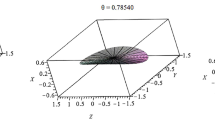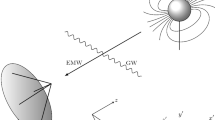Abstract
The perturbation of Dirac particles moving in a constant magnetic field is calculated for simultaneously incident parallel monochromatic circular polarized electromagnetic and gravitational waves. Resonances are found which depend on the initial energy of the charged particles, the magnetic field, and the frequencies of the incident waves. A suited choice of these parameters allows the selection of only one resonance that is proportional to the product of the squares of the amplitudes of both waves. This effect is valid for all bound systems of Dirac particles interacting simultaneously with electromagnetic and gravitational waves. At least in principle this resonance effect can be used to detect the gravitational waves in the lab. For regions of the universe with strong electromagnetic and gravitational waves and suited magnetic fields this effect may play another important part for the acceleration of charged particles.
Similar content being viewed by others
REFERENCES
Abramovici, A., Althouse, W. E., Drever, R. W. P., Gürsel, Y., Kawamura, S., Raab, F. J., Shoemaker, D., Sievers, L., Spero, R. E., Thorne, K. S., Vogt, R. E., Weiss, R., Whitcomb, S. E., and Zucker, M. E. (1992). LIGO: The laser interferometer gravitational-wave observatory, Science 256, 325.
Abramovici, A., Althouse, W., Camp, J., Durance, D., Giaime, J. A., Gillespie, A., Kawamura, S., Kuhnert, A., Lyons, T., Raab, F. J., Savage Jr., R. L., Shoemaker, D., Sievers, L., Spero, R., Vogt, R., Weiss, R., Whitcomb, S., and Zucker, M. (1996). Improved sensitivity in a gravitational wave interferometer and implications for LIGO, Physics Letters A 218, 157.
Abramowitz, M. and Stegun, I. A. (1968). Handbook of Mathematical Functions, Dover Publications, New York, pp. 509ff, 773ff.
Adler, R., Bazin, M., and Schiffer, M. (1965). Introduction to General Relativity, McGraw-Hill, New York.
Babusci, D., Fang, H., Giordano, G., Matone, G., Matone, L., and Sannibale, V. (1997). Alignment procedure for the VIRGO interferometer: Experimental results from the Frascati prototype, Physics Letters A 226, 31.
Braginskij, V. B., Manukin, A. B., Popov, E. I., Rudenko, V. N., and Khoren, A. A. (1972). Search for gravitational radiation of extraterrestrial origin, JETP Letters 16, 108.
Braginskij, V. B. and Rudenko, V. N. (1970). Relativistic gravitational experiments, Soviet Physics-Uspekhi 13, 165.
Brill, D. R. and Wheeler, J. A. (1957). Interaction of neutrinos and gravitational fields, Reviews of Modern Physics 29, 465.
Brunner, W. and Junge, K. (1989). Lasertechnik, Dr. Alfred Hüthig Verlag, Heidelberg.
Caldwell, R. R., Kamionkowski, M., and Wadley, L. (1999). The first space-based gravitational-wave detectors, Physical Review D 59, 027101.
Drever, R. W. P., Hough, J., Bland, R., Lessnoff, G. W. (1973). Search for short bursts of gravitational radiation, Nature 246, 340.
Harry, G. M., Stevenson, T. R., and Paik, H. J. (1996). Detectability of gravitational wave events by spherical resonant-mass antennas, Physical Review D 54, 2409.
Ketsaris, A. A. (1974). Gravitational field of a plane electromagnetic wave, Soviet Physics Journal 17, 689.
Landau, L. D. and Lifschitz, E. M. (1966). Lehrbuch der theoretischen Physik, Akademie-Verlag-Berlin, Berlin, Vol. 2.
Levine, J. L. and Garwin, R. L. (1973). Absence of gravity-wave signals in a bar at 1695 Hz, Physical Review Letters 31, 173.
Macedo, P. and Nelson, H. (1990). Perturbation of Larmor orbits by a gravitational wave, Astrophysical Journal 362, 584.
Maischberger, K., Rüdiger, A., Schilling, R., Schnupp, L., Winkler, W., Leuchs, G. (1991). Status of the garching 30 meter prototype for a large gravitationalwave detector. In Experimental Gravitational Physics, P. F. Michelson, En-Ke Hu, and G. Pizzella, eds., World Scientific, Singapore, pp. 316–321.
Misner, C. W., Thorne, K. S., and Wheeler, J. A. (1973). Gravitation, W. H. Freeman, San Francisco.
Papadopoulos, D. and Esposito, F. P. (1981). On the transformation of gravitational radiation into electromagnetic radiation, Astrophysical Journal 148, 783.
Redmond, P. J. (1965). Solution of the Klein-Gordon and Dirac equations for a particle with a plane electromagnetic wave and a parallel magnetic field, Journal of Mathematical Physics 6, 1163.
Schnier, D., Mizuno, J., Heinzel, G., Lück, H., Rüdiger, A., Schilling, R., Schrembel, M., Winkler, W., Danzmann, K. (1997). Power recycling in the Garching 30 m prototype interferometer for gravitational-wave detection, Physics Letters A 225, 210.
Schutz, B. F. (1997). Relativistic gravitation and gravitational radiation. In Proceedings of the Les Houches School of Physics, Les Houches, Haute Savoie, 26 September–6 October, 1995, J.-A. Marck and J.-P. Lasota, eds., Cambridge University Press, Cambridge, pp. 447–475.
Shaddock, D. A., Gray, M. B., and McClelland, D. E. (1998). Experimental demonstration of resonant sideband extraction in a Sagnac interferometer, Applied Optics 37, 7995.
Sokolov, A. A. and Ternov, I. M. (1968). Synchrotron Radiation, Akademie-Verlag-Berlin, Berlin.
Tyson, J. A. (1973). Null search for bursts of gravitational radiation, Physical Review Letters 31, 326.
Weber, J. (1960). Detection and generation of gravitational waves, Physical Review 117, 306.
Weber, J. (1969). Evidence for discovery of gravitational radiation, Physical Review Letters 22, 1320.
Author information
Authors and Affiliations
Rights and permissions
About this article
Cite this article
Schorn, HJ. New Effect for Detecting Gravitational Waves by Amplification with Electromagnetic Radiation. International Journal of Theoretical Physics 40, 1427–1452 (2001). https://doi.org/10.1023/A:1017553427357
Issue Date:
DOI: https://doi.org/10.1023/A:1017553427357




